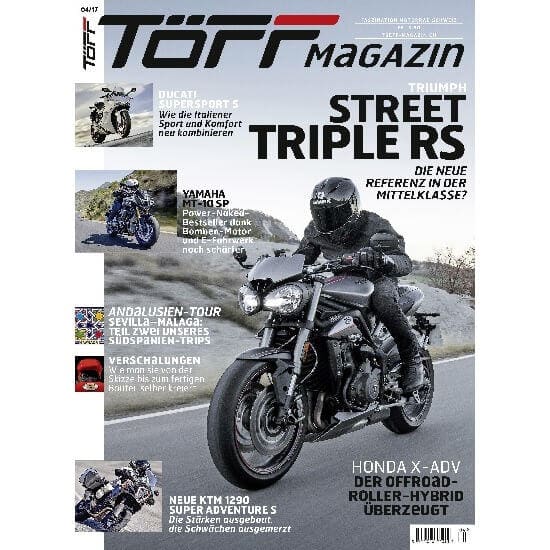Yamaha MT-07 - Zur Reife gebracht
Inzwischen ist jede vierte verkaufte Yamaha eine Yamaha MT-07. Für die Japaner Grund genug, ihren unbestrittenen Bestseller mit sanften Retuschen in die Neuzeit zu überführen.
— Text: Daniele Carrozza — Fotos: Alessio Barbanti, Jonathan Godin
Eindrückliche Zahlen 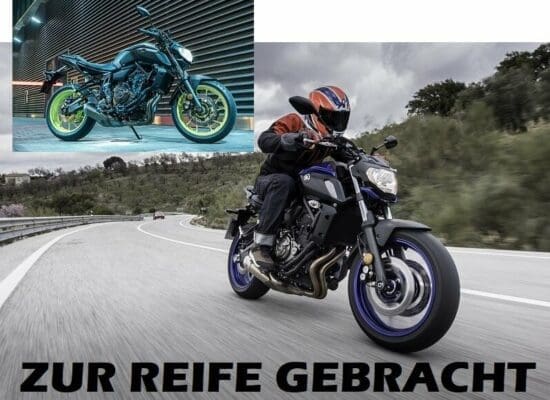
fliegen uns anlässlich der offiziellen Pressevorstellung der neuen
Yamaha MT-07 um die Ohren. So soll seit 2014 jede zweite verkaufte Yamaha der MT-Familie zuzuordnen sein, wobei hier wiederum 45 Prozent des Volumens aufs Konto der Yamaha MT-07 gehen. 1176 Einheiten des quirligen Einsteiger-Naked-Bikes wurden im letzten Jahr allein in der Schweiz neu zugelassen, womit die MT-07 die hiesige Zulassungsstatistik komfortabel anführt – sehr komfortabel sogar. Es versteht sich von selbst, dass Yamaha bei der MT-07 an besagtem Bestsellerstatus festhalten will. Doch seit der Lancierung der quicklebendigen Preis-Leistungs-Bombe sind inzwischen doch vier Jahre ins Land gegangen. Höchste Zeit also, der Yamaha MT-07 eine Modellpflegekur zu verpassen. Nun ist das Update eines Bestsellers allerdings eine heikle Angelegenheit. Wird zu konservativ Hand angelegt, zieht die Konkurrenz links vorbei, und der Bestsellerstatus geht flöten. Wird dagegen übermotiviert interveniert, besteht die Gefahr, bei Design und insbesondere Preis übers Ziel hinauszuschiessen. Die Kunst besteht also darin, die goldene Mitte zwischen Behutsamkeit und Innovation zu treffen. Im Falle der Yamaha MT-07 waren wir, um ehrlich zu sein, etwas besorgt, als wir das 2018er-Modell an der EICMA erstmals zu Gesicht bekamen. «Die haben ja gar nichts gemacht!», war unsere erste Reaktion. Schaut man jedoch genauer hin, erfolgt dann aber schnell so manches «Aha!»-Erlebnis.
Ergonomie, Fahrwerk,
Aus Kundenbefragungen weiss Yamaha, dass 70 Prozent aller MT-07-Fahrer ihr Bike Tag für Tag nutzen. Entsprechend sollten die Alltagsqualitäten gesteigert werden. Geschehen ist dies über die Überarbeitung der neu zu einem Teil vereinten Sitzpolster für Fahrer und Beifahrer, wobei die zugängliche Sitzhöhe von 805 mm unverändert geblieben ist. Beide Polster wurden verlängert, wobei der Fahrersitz im Schrittbogen eine neue Kontur erhalten hat und zudem weiter nach vorne bis unter den Tank gezogen wurde.
Handlungsbedarf sah Yamaha auch beim Fahrwerk. Bekanntermassen animiert die flinke Yamaha MT-07 zu sportlichem Kurvenwetzen, wobei sie gerade hier weit mehr drauf hat, als man ihr zugestehen würde. Allerdings kamen die generell etwas unterdämpften Federelemente irgendwann dann doch an ihre Grenzen. Entsprechend wurde das 2018er-Modell einen Zacken straffer abgestimmt. An der 41-mm-Telegabel über neue Federn mit um sechs Prozent gesteigerter Federrate sowie durch den Einsatz eines Gabelöls mit niedrigerer Viskosität. Die Zugstufen-Dämpfkraft soll so um 16 Prozent gesteigert worden sein. Hinten kommt ein komplett neues Kayaba-Zentralfederbein mit einem besser bedienbaren Mechanismus zur Einstellung der Federbasis zum Einsatz. Es bietet zudem neu die Möglichkeit, die Zugstufendämpfung zu regulieren, und kommt mit einer um 11 Prozent gesteigerten Federrate. Die Zugstufen-Dämpfkraft wurde im Highspeed-Bereich um 27, die Druckstufen-Dämpfkraft gar um satte 40 Prozent erhöht.
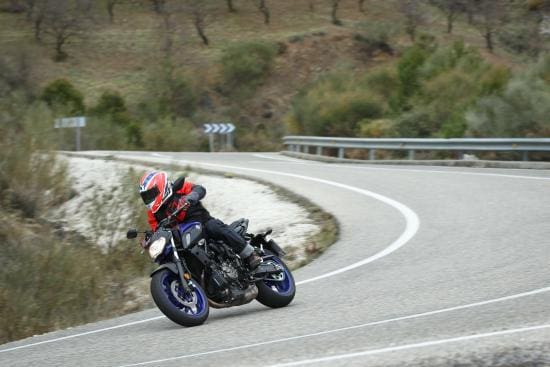
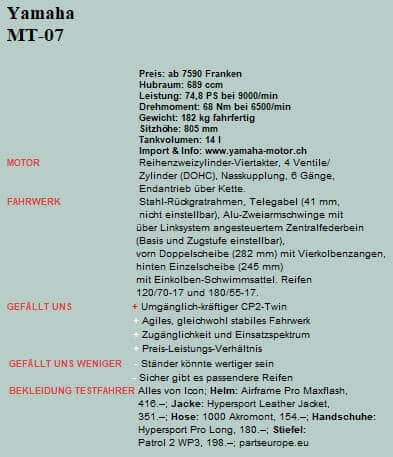
Design weniger verspielt
Bleibt das Design, das sich beim 2018er-Jahrgang etwas weniger verspielt und damit erwachsener präsentiert. Neu sind die Tankschale, die sich aus nunmehr drei statt fünf Komponenten zusammensetzt, der einteilige vordere Kotflügel (zuvor drei Einzelteile), die hübschen seitlichen Deflektorflügel am Heck sowie die neue Rückleuchte im MT-09-Stil. Auch der Scheinwerfer mit zwei seitlichen statt einem zentralen Tagfahrlicht ist ein komplett neues Bauteil. Die Tatsache, dass das Scheinwerferdesign nach wie vor eher brav daherkommt, begründet Yamaha mit der sehr breiten Zielgruppe. Die könne man am besten mit einem «mehrheitsfähigen» Design ansprechen. Zudem solle die MT-07 klar von der aggressiver gezeichneten MT-09 abgegrenzt werden.
Liebe auf den ersten Ritt
Und was hat sie nun drauf, die ab sofort für 7590 Franken – die 300 Stutz Aufpreis gegenüber der Vorgängerin sind auf die hochwertigeren Komponenten zurückzuführen – in Schwarz, Blau-Schwarz und Gelb-Dunkelgrau erhältliche neue MT-07? Die kurvenreichen, grösstenteils aber klatschnassen Strassen im Hinterland von Marbella in Südspanien werden uns helfen, diese Frage zu beantworten.
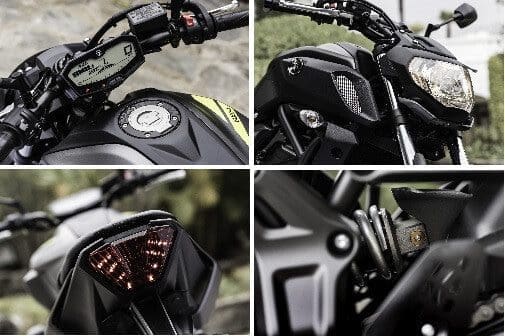
Schon in der Hotelausfahrt erneuert sich meine Liebe zum CP2-Twin mit 689 ccm Hubraum, einer Maximalleistung von 75 PS und 68 Nm Drehmoment. Ein herrlicher Antrieb mit unglaublich geschmeidiger Ansprache, sattem Druck bereits von ganz unten, vorbildlich-linearer Leistungsentfaltung und einer richtig erfrischenden Drehfreude. Egal, ob Mitschwimmen in der City-Rushhour, genüssliches Touren (auch zu zweit) oder sportives Rastenschleifen am Pass – der CP2 ist sich für keine Disziplin zu schade. Und ja, der wackere Reihenzweizylinder ist eins zu eins derselbe geblieben, doch gab und gibt es hier aus unserer Sicht auch absolut keinen Handlungsbedarf. Auch das knackig-präzis arbeitende Getriebe und die sauber dosierbare Zweifingerkupplung lassen keinerlei Wünsche offen. Motorseitig bleibt glücklicherweise also alles beim guten Alten. Was auch für den dumpfen, dank 270 Grad Hubzapfenversatz einem V2 ähnelnden Sound gilt.
Flinkes Fahrwerk dank neuen Komponenten
Ein deutlicher Schritt nach vorn ist dagegen beim Fahrwerk der fahrfertig 182 Kilo wiegenden Mittelklasse-MT auszumachen – speziell auf gezeichnetem Asphalt: Sie bleibt flink wie ein Velo, doch die neuen Fahrwerkskomponenten dämpfen spürbar souveräner, schaukeln dadurch weniger und vermitteln zudem ein klareres Feedback. Das schafft Vertrauen – gerade bei Regen. Ob es einen passenderen Gummi als den Bridgestone BT-023 gibt, darüber lässt sich streiten. Nicht aber über die Tatsache, dass hier ein nahezu perfekter Mix aus Handling und Stabilität vorliegt. Auch nicht über die Bremsen: Die geben sich bezüglich Ansprache nicht zu giftig und damit einsteigerfreundlich, sie lassen sich prima dosieren und können auf Wunsch auch richtig kräftig zupacken. ABS? Top!
Bleibt die Ergonomie: Platzverhältnisse? Speziell für Grossgewachsene besser. Komfort? Auf sehr hohem Niveau – trotz gesteigerter Sportlichkeit.
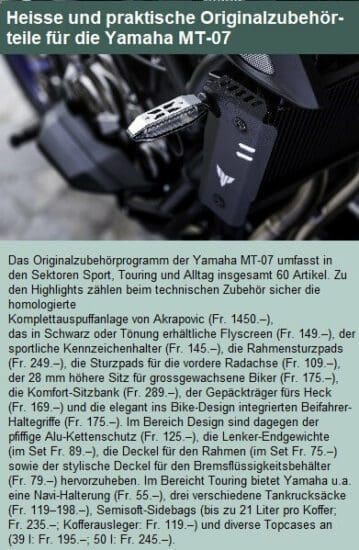
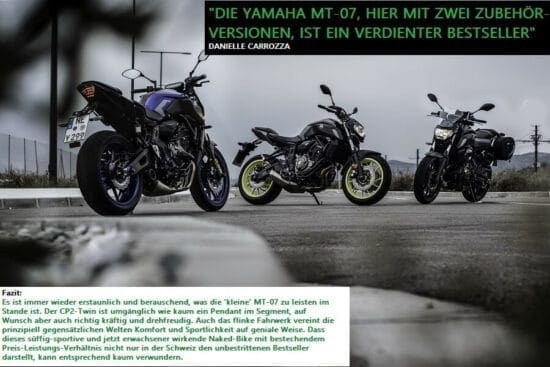
TÖFF MAGAZIN - FASZINATION MOTORRAD IM ABO
TÖFF Magazin im Abo mit kompetenten Recherchen, fundierten Tests und Modellvorstellungen, rasante Reportagen und opulente Fotografie und umfangreiche Service-Themen.
Möchten Sie regelmässig das Magazin TÖFF lesen, empfehlen wir Ihnen TÖFFzu abonnieren.
Hier:
TÖFF MAGAZIN abonnieren

 fliegen uns anlässlich der offiziellen Pressevorstellung der neuen
fliegen uns anlässlich der offiziellen Pressevorstellung der neuen
 Schon in der Hotelausfahrt erneuert sich meine Liebe zum CP2-Twin mit 689 ccm Hubraum, einer Maximalleistung von 75 PS und 68 Nm Drehmoment. Ein herrlicher Antrieb mit unglaublich geschmeidiger Ansprache, sattem Druck bereits von ganz unten, vorbildlich-linearer Leistungsentfaltung und einer richtig erfrischenden Drehfreude. Egal, ob Mitschwimmen in der City-Rushhour, genüssliches Touren (auch zu zweit) oder sportives Rastenschleifen am Pass – der CP2 ist sich für keine Disziplin zu schade. Und ja, der wackere Reihenzweizylinder ist eins zu eins derselbe geblieben, doch gab und gibt es hier aus unserer Sicht auch absolut keinen Handlungsbedarf. Auch das knackig-präzis arbeitende Getriebe und die sauber dosierbare Zweifingerkupplung lassen keinerlei Wünsche offen. Motorseitig bleibt glücklicherweise also alles beim guten Alten. Was auch für den dumpfen, dank 270 Grad Hubzapfenversatz einem V2 ähnelnden Sound gilt.
Schon in der Hotelausfahrt erneuert sich meine Liebe zum CP2-Twin mit 689 ccm Hubraum, einer Maximalleistung von 75 PS und 68 Nm Drehmoment. Ein herrlicher Antrieb mit unglaublich geschmeidiger Ansprache, sattem Druck bereits von ganz unten, vorbildlich-linearer Leistungsentfaltung und einer richtig erfrischenden Drehfreude. Egal, ob Mitschwimmen in der City-Rushhour, genüssliches Touren (auch zu zweit) oder sportives Rastenschleifen am Pass – der CP2 ist sich für keine Disziplin zu schade. Und ja, der wackere Reihenzweizylinder ist eins zu eins derselbe geblieben, doch gab und gibt es hier aus unserer Sicht auch absolut keinen Handlungsbedarf. Auch das knackig-präzis arbeitende Getriebe und die sauber dosierbare Zweifingerkupplung lassen keinerlei Wünsche offen. Motorseitig bleibt glücklicherweise also alles beim guten Alten. Was auch für den dumpfen, dank 270 Grad Hubzapfenversatz einem V2 ähnelnden Sound gilt.


